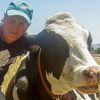For more than ten years, I've been teaching animal behavior and conservation biology at the Boulder County Jail in Colorado as part of the Jane Goodall Institute's Roots & Shoots Program. The course is one of the most popular in the jail. Students have to earn the right to enroll and they work hard to get in it.
Many of the students find it easier to connect with animals than with people because animals don't judge them and the animals trust them. Many of the inmates had lived with dogs, cats, and other companions who were their best, and in some cases their only, friends; and for some they were family. They trust and empathize with animals in ways they don't with humans.
While there's student turnover, jail workers and I remain pleasantly surprised at how this course connects the inmates to various aspects of nature. I try to correct a prevailing and distorted view of how animals treat one another. At one of the first meetings, someone was talking out of turn as I was setting up the video of the day. One of the guys yelled, "Hey, shut up, you're acting like an animal. This guy's here to help us."
I immediately responded, "You've just paid him a compliment," explaining that, while surely there is competition and aggression among animals, there's also a lot of cooperation, empathy, and reciprocity, observed during a number of different social interactions, including social play I explained that these "positive" or prosocial behaviors are examples of "wild justice." This made them rethink what it means to be an animal. They've had enough of nature red in tooth and claw.
Topics we actively discuss range from general aspects of animal behavior to cultural views of animals, and evolution and creationism to animal protection and environmental ethics. We look at who we are in the grand scheme of things -- anthropocentric influences on animals and the environment.
When we discuss wildlife conservation, almost all of the inmates have something to say. They're uniformly against killing wolves just because they kill livestock, and they get really upset when we discuss how destructive humans can be to animals and habitats. Our discussions about hunting are very interesting, with trophy and sport hunting really frowned upon. Our exchanges rival those that I've had at university classes.
Importantly, many of the students see the class as building community with animals and with people. They yearn to build healthy relationships. I use examples of the social behavior of group-living animals such as wolves as a model for developing and maintaining long-term friendships among individuals who must work together, not only for their own good, but also for the good of the group.
Many write essays about their experience in the class that I use in my own writing and lectures, and there are some phenomenal artists among them who have create award-winning drawings.
When asked what they get out of the class, they've responded:
I've learned a lot about understanding and appreciating animals as individuals.
The class gives us a sense of connection to webs of life.
What I do counts.
I now have a positive vision for the future.
The course is healing.
I've been told that, because of the class, some of the inmates' kids are more likely to go into science. I know some students have gone back to school, while others have made contributions in time and money to conservation organizations. During the course, some contributed to animal rescue programs, including one with which I work that rescues and rehabilitates Asiatic moon bears. Some have gone on to work for humane societies. One student received a master's degree in nature writing. When I ran into him in Boulder, he was so proud of how his life had changed, I got teary; he'd been able to stay out of jail and pursue his dreams.
By discussing animal behavior and conservation in my course, doors were opened for the inmates to build understanding, trust, cooperation, community, and hope.
